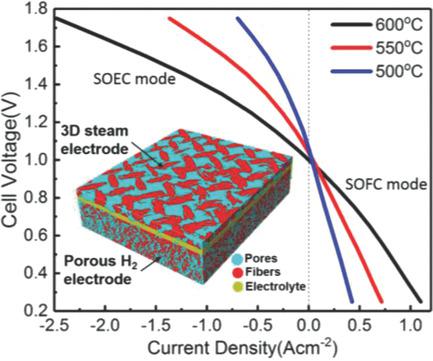Our official English website, www.x-mol.net, welcomes your
feedback! (Note: you will need to create a separate account there.)
3D Self‐Architectured Steam Electrode Enabled Efficient and Durable Hydrogen Production in a Proton‐Conducting Solid Oxide Electrolysis Cell at Temperatures Lower Than 600 °C
Advanced Science ( IF 14.3 ) Pub Date : 2018-08-31 , DOI: 10.1002/advs.201800360 Wei Wu 1 , Hanping Ding 1 , Yunya Zhang 1 , Yong Ding 2 , Prashant Katiyar 3 , Prasun K Majumdar 3 , Ting He 1 , Dong Ding 1
Advanced Science ( IF 14.3 ) Pub Date : 2018-08-31 , DOI: 10.1002/advs.201800360 Wei Wu 1 , Hanping Ding 1 , Yunya Zhang 1 , Yong Ding 2 , Prashant Katiyar 3 , Prasun K Majumdar 3 , Ting He 1 , Dong Ding 1
Affiliation

|
Hydrogen production via water electrolysis using solid oxide electrolysis cells (SOECs) has attracted considerable attention because of its favorable thermodynamics and kinetics. It is considered as the most efficient and low‐cost option for hydrogen production from renewable energies. By using proton‐conducting electrolyte (H‐SOECs), the operating temperature can be reduced from beyond 800 to 600 °C or even lower due to its higher conductivity and lower activation energy. Technical barriers associated with the conventional oxygen‐ion conducting SOECs (O‐SOECs), that is, hydrogen separation and electrode instability that is primarily due to the Ni oxidation at high steam concentration and delamination associated with oxygen evolution, can be remarkably mitigated. Here, a self‐architectured ultraporous (SAUP) 3D steam electrode is developed for efficient H‐SOECs below 600 °C. At 600 °C, the electrolysis current density reaches 2.02 A cm−2 at 1.6 V. Instead of fast degradation in most O‐SOECs, performance enhancement is observed during electrolysis at an applied voltage of 1.6 V at 500 °C for over 75 h, attributed to the “bridging” effect originating from reorganization of the steam electrode. The H‐SOEC with SAUP steam electrode demonstrates excellent performance, promising a new prospective for next‐generation steam electrolysis at reduced temperatures.
中文翻译:

3D 自架构蒸汽电极可在低于 600 °C 的温度下在质子传导固体氧化物电解池中高效、持久地生产氢气
使用固体氧化物电解池(SOEC)电解水制氢因其良好的热力学和动力学而引起了广泛关注。它被认为是利用可再生能源生产氢气的最有效和低成本的选择。通过使用质子传导电解质(H-SOEC),由于其更高的电导率和更低的活化能,工作温度可以从800℃以上降低到600℃甚至更低。与传统氧离子传导SOEC(O-SOEC)相关的技术障碍,即氢分离和电极不稳定性(主要是由于高蒸汽浓度下的镍氧化以及与氧气析出相关的分层)可以得到显着缓解。在此,开发了一种自架构超多孔 (SAUP) 3D 蒸汽电极,用于在 600 °C 以下的温度下实现高效 H-SOEC。在 600 °C 时,电解电流密度在 1.6 V 下达到 2.02 A cm -2 。大多数 O-SOEC 并没有快速降解,而是在 500 °C 施加 1.6 V 电压下电解超过 75 小时,观察到性能增强。 ,归因于蒸汽电极重组产生的“桥接”效应。具有 SAUP 蒸汽电极的 H-SOEC 表现出优异的性能,为下一代低温蒸汽电解带来了新的前景。
更新日期:2018-08-31
中文翻译:

3D 自架构蒸汽电极可在低于 600 °C 的温度下在质子传导固体氧化物电解池中高效、持久地生产氢气
使用固体氧化物电解池(SOEC)电解水制氢因其良好的热力学和动力学而引起了广泛关注。它被认为是利用可再生能源生产氢气的最有效和低成本的选择。通过使用质子传导电解质(H-SOEC),由于其更高的电导率和更低的活化能,工作温度可以从800℃以上降低到600℃甚至更低。与传统氧离子传导SOEC(O-SOEC)相关的技术障碍,即氢分离和电极不稳定性(主要是由于高蒸汽浓度下的镍氧化以及与氧气析出相关的分层)可以得到显着缓解。在此,开发了一种自架构超多孔 (SAUP) 3D 蒸汽电极,用于在 600 °C 以下的温度下实现高效 H-SOEC。在 600 °C 时,电解电流密度在 1.6 V 下达到 2.02 A cm -2 。大多数 O-SOEC 并没有快速降解,而是在 500 °C 施加 1.6 V 电压下电解超过 75 小时,观察到性能增强。 ,归因于蒸汽电极重组产生的“桥接”效应。具有 SAUP 蒸汽电极的 H-SOEC 表现出优异的性能,为下一代低温蒸汽电解带来了新的前景。











































 京公网安备 11010802027423号
京公网安备 11010802027423号